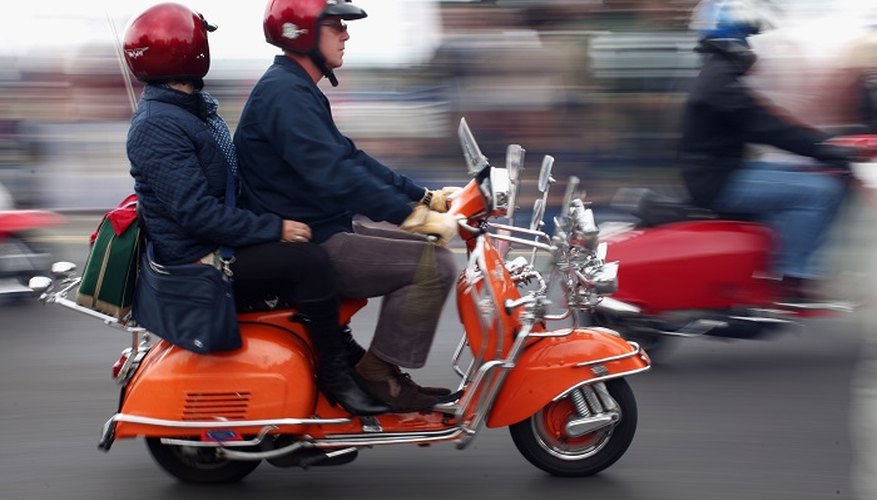Many scooters made and sold today come with a disc brake on the front wheel, which generally involves working with a hydraulic fluid line and caliper for adjustments. However, the rear wheel on many scooters and both wheels on classic vintage scooters still use drum brakes. These drum brakes are activated by a control cable connected either to the foot brake cable or the front brake lever on the handle. Adjustment is straightforward and requires only a few tools. At a minimum, every scooter owner with drum brakes should know how to make changes since she may end up needing to do the adjustment on the side of a road.
- Many scooters made and sold today come with a disc brake on the front wheel, which generally involves working with a hydraulic fluid line and caliper for adjustments.
Identify which wheel's brake you need to adjust, front or back. Find the cable lever that connects to the brake hub and activates the brake shoes inside. Push the activating arm inward to see how much play there is before the brake shoes engage -- you should be able to feel the resistance with your hand when pressing far enough.
Loosen the cable securing nut with a crescent wrench if you find too much play in the cable. Take a third-hand plier tool -- a wrench that grabs the steel cable and pulls it tight -- and apply tension to the brake cable, removing almost all slack before the brake shoe engages.
- Loosen the cable securing nut with a crescent wrench if you find too much play in the cable.
- Take a third-hand plier tool -- a wrench that grabs the steel cable and pulls it tight -- and apply tension to the brake cable, removing almost all slack before the brake shoe engages.
Lock the third-hand tool in place if it has a locking feature. Otherwise, keep the tool tight while you re-tighten the cable nut until it's tight. Release the third-hand tool and tug on the cable a little by hand to make sure it doesn't come loose.
Stand up and take the scooter off its kickstand. Sit on the scooter so you can rock it back and forth. Rock it forward and apply the brake pedal or handle for the wheel you adjusted. Apply the brake fully while moving to check that it works and the cable doesn't pop loose. Confirm the brakes stop the scooter successfully.
Take the scooter for a test ride. Apply the brakes while riding using a full stop at speed as a final test.
TIP
You can get the cable third-hand tool at most scooter or motorcycle suppliers. The version with a locking feature is handy as it will hold the tightened cable in place, freeing both hands to tighten the securing nut.
WARNING
Old vintage scooters use a damper in the front that requires a bit of slack in the front brake drum. If the cable is tightened too much, the front wheel will lock up without slowing down when applied, possibly causing the scooter and rider to flip over the front wheel. This is a common problem with early, 20 cm (8 inch) wheel Vespa scooters. Unfortunately, making the adjustment correctly means the front wheel will not brake well, and stopping power then relies heavily on the rear wheel brakes.
